Below is a list of Collieries/mines/pits/shafts which at one time operated in Clackmannanshire. Many of the pits listed below have since been filled in / capped / remediated in some way.
This page, like most others here on Clackmannanshire.Scot, is very much subject to review and revision, as further or more accurate information becomes available, including locations, operating dates, and working practices.
We will try to locate all of the Clackmannanshire pits, and possibly, date them and chart them on a map.
If you know anything about Clackmannanshire's mines or can help with the workings listed or indeed not listed below, please get in touch.
Mining
The first authentic accounts we have of coal being wrought in Scotland, was in the lands belonging to the Abbey of Dunfermline, in the year 1291. The first pit in Clackmannanshire was reputedly opened at Alloa in 1519, and pits at Kennetpans are recorded as supplying coal for extraction of salt from sea-water. Machines used for draining the pits were first recorded around 1600, and further pits are recorded as having been opened at Alloa and Sauchie around 1603.
Mines - Coal
Alloa
Alloa Colliery : Mitchell and Company {1854}, Alloa Coal Co. {1893}, Alloa Coal Co. {1908}
Alloa, Whinhall Pit No. 1 - Started 1873. Closed 1936. - Alloa Coal Company. Sometimes known as Whinhill pit (as in the OS map Below), it was located near the Alloa to Clackmannan stretch of the Stirling and Dunfermline Railway, at the north side of the tracks where the Morrisons roundabout currently sits. There is currently a pond nearby which was created by mining subsidence and flooding.
2025 : The area has recently been cleared of trees and the elevated pit bing and raised sidings area can be seen more clearly. The pond mentioned above has been excavated, presumably prior to development.
Alloa, Whinhall Pit No. 2 - Started ? Closed (before 1901). - Alloa Coal Company. Shown as 'old shaft' on the picture below, it was located roughly where the Alloa Fire Station now stands.
Alloa, Whinhall Pit No. 3 - Started 1902. Closed 1919.
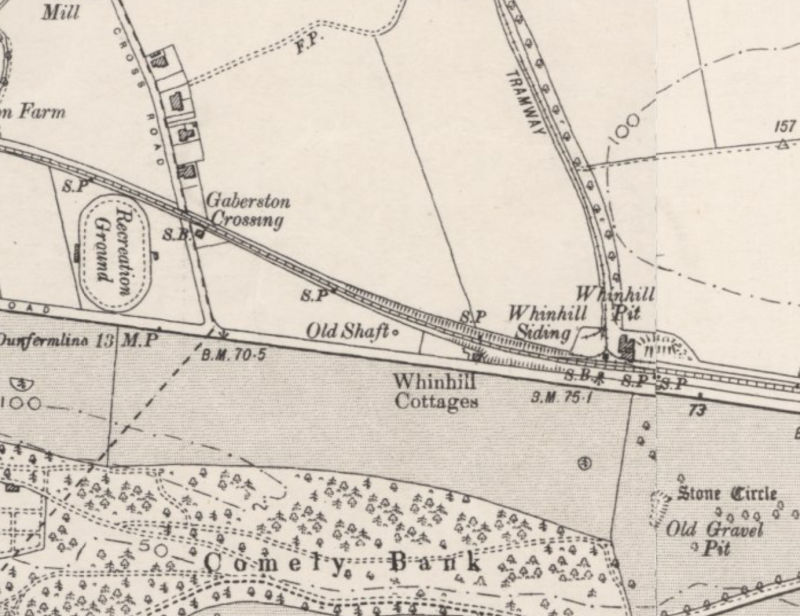
OS Map 1901
Jellyholm Colliery (Jellyholm pit) - Started 1887. Closed 1921. - Alloa Coal Company. Located near the west end of the Gartmorn Dam, this pit became unprofitable and was closed in 1921.
Brandyhill Pit {1852}
Crandra Pit - Open for a short time, a walled shaft remains, located in what is now Sunnyside Cemetery, Alloa. The pit existed prior to the land becoming a cemetery. Houses near the pit included Crandra Row at the Whins, since demolished.
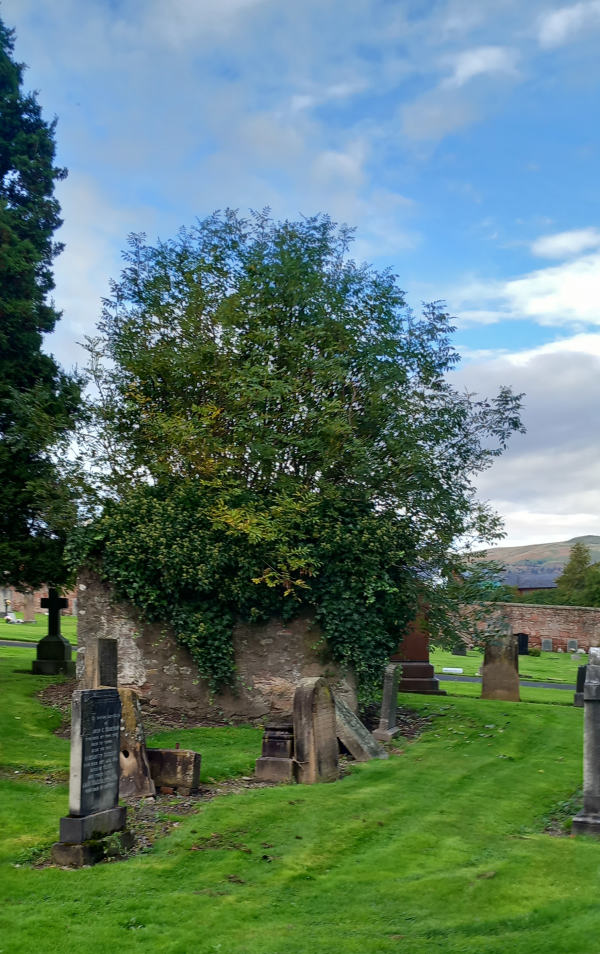
Crandra Pit shaft - walled off
Pic. - October 2023
Greyhound Pit No 1 and No. 2 - Located East of Hillpark
Old Mains Pit - Alloa Coal Co. (closed September 1886) Located East of Hillpark
Cauldhame Pit - East of Jellyholm Pit
Whinnyhall (closed sept 1883)
Broom Pit - Alloa Coal Co. {1873} Located on the site of the Hillton Fire Clay Brick and Tile works, on the side of the Brothie (Brathy) Burn to the south of Carsebridge Distillery.
It was connected via tramway to Whinhall Pit No.3.
Forthbank Colliery, Forthbank, Alloa 1892 - 1902, Alloa Coal Co. Re-opened, closed 1954. Located near to where the current council refuse collection depot now is.
Alva
Alva coal mine: (Caroline Pit / Caroline Row Pit) (1860 to 1875)
Owned by James Johnstone, Alva mine was situated to the south of Alva on the northern bank of the river Devon. It was linked to a brick works on the southern edge of the village via a short waggonway.

James is known to have owned the mine in 1860 and also other properties in the area. James donated Johnstone Park to the local people in 1856.
Alva No. 1 - 1872 Located immediately to the south of the Alva Railway Station site.
Alva No. 2 - 1873 Located at the Alva Burn at Brook Street (opposite the Boll Cottages).
Westhaugh shaft was located near to Westhaugh, just south of Alva.
Benview
Blackfaulds Pit - at the east end of Benview Terrace.
Willie's Pulpit pit - located on the south side of the road between Benview and Devonside.
Arns Well Pit
Whitelaws Pit
Cambus
Blackgrange No. 1 1889
Blackgrange No. 2 1902-1903
Haugh of Blackgrange No. 1 - 1889
Clackmannan
Clackmannan [Mitchell and Company] {1854}, [Mitchell and Moubray] {1866} [Clackmannan Coal Co] {1869}, (closed May 1878)
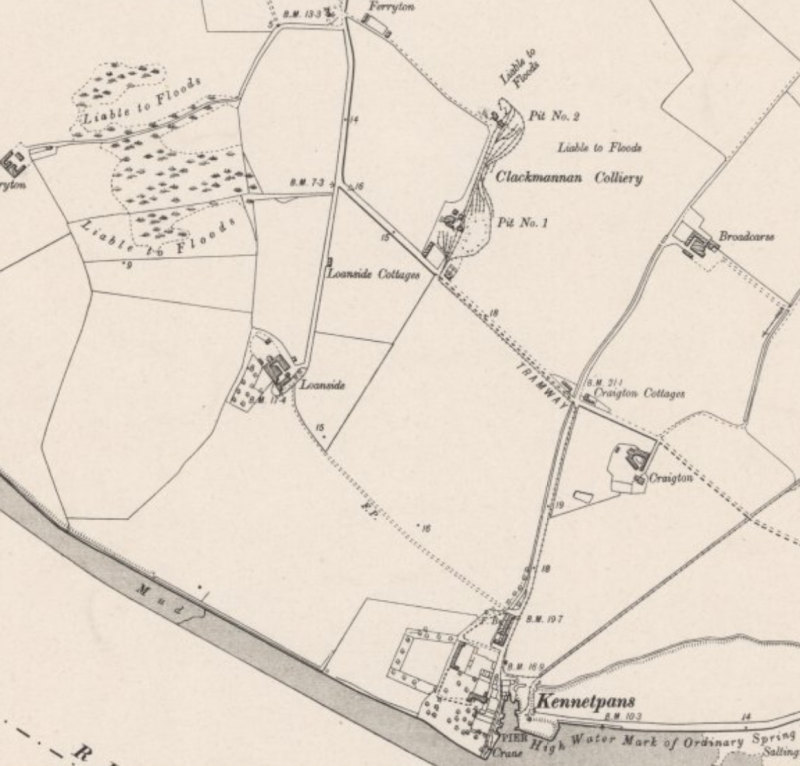
OS Map 1901
Clackmannan Pit No.1 and Pit No.2 were located beside each other on the carse south of Clackmannan near Ferryton to the north of Kennetpans.
Clackmannan No. 14 - Clackmannan Coal Co. {1866} (closed October 1878)
Clackmannan No. 15 - Clackmannan Coal Co. {1866} (Closed November 1884) Located opposite Lady wood on the road out to Linn Mill.
Lady Wood Pit - Located at the bank of the Black Devon at the south side of the former Railway Viaduct.
Southfield 5 - Clackmannan Coal Co. {1873}
Clackmannan pit shown as in service 1893, Clackmannan Coal Co.
Old Mill Pit - located just east of Riccarton, Clackmannan
Craigrie - Opened 1852 [Devon Iron Company] {1854}, Tulligarth Coal Co. Ltd {1938} and {1939}, Alloa Coal Co. acquired the pit in 1942 and re-equipped it. NCB 1947 until the mine closed in 1952.
Craigrie Pit was located just across the road from Craigrie farm, to the immediate south of Clackmannan Tower. Minor remnants of the site - hard standing and low walls - still exist. the site is now used by the farm for storage.
Zetland Colliery (1935 to 1960) - Alloa Coal Co - 1935-1947. NCB - 1947-1960.
Zetland No. 1 and No. 2 - Located to the north of Helensfield on the north side of the A907.
Muir Pit - Located at what is now St. Serf's Roadin Clackmannan.
Tulligarth (Tullygarth) A.K.A. Pretoria Pit - Jas. Fyfe and Co. 1908, Tulligarth Coal Co. Ltd {1918 to 1941}, Alloa Coal Co. took over the pit in 1941, and was registered as still owning it in 1944 and 1945, Reported to have closed in 1944.
Tulligarth is located to the immediate east of the Cherryton brick works - the clay spoil from the mine was used to make the bricks.
Tulligarth No. 1 - Tulligarth Coal Co. Ltd - Located East of Pretoria pit.
Tulligarth No. 3 - Tulligarth Coal Co. Ltd {1918} - work suspended September 1921. - Located east of Pretoria pit and south of Tulligarth No. 1, on the north side of the railway.
Tulligarth No. 4 - Tulligarth Coal Co. Ltd - Located just west of Forestmill Station.
Water-Mill Pit - Possibly located east of Heatherhouse (Clackmannan Pow) to the south of Clackmannan, 1740's, [Update] CFSS research puts this pit just east of the Craigrie pit location.
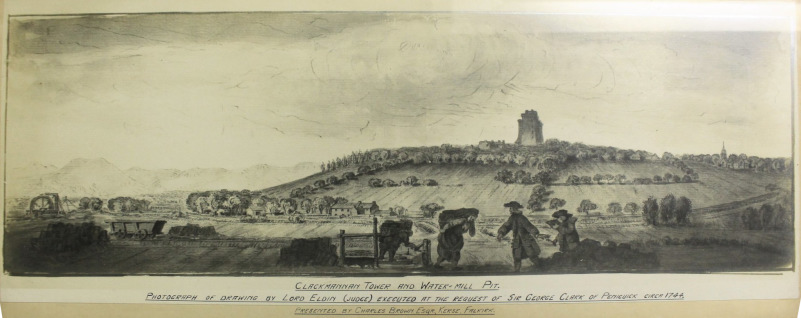
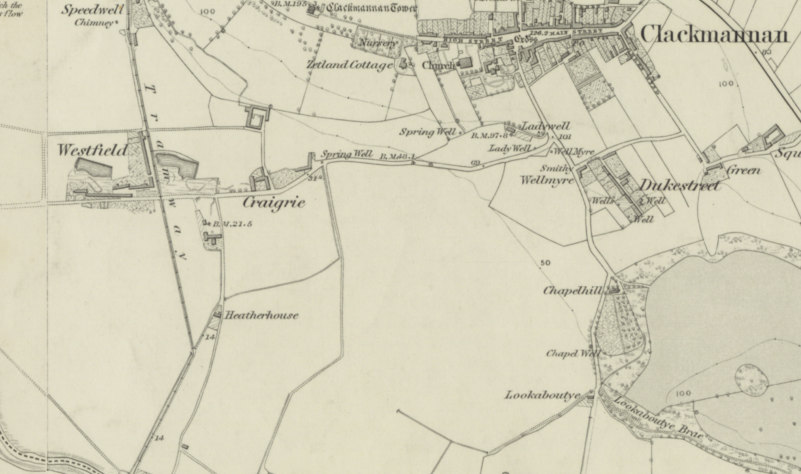
OS map 1843
Coalsnaughton
Sherrifyards Colliery - Sheriffyards No.1, 2 and 3 - Located at the east end of Gartmorn Dam - Opened by the Alloa Coal Co. in 1895, Closed 1921.
Garnstar? (Ganister?) [Probably Gartenstars pit, listed below][Alloa Coal Co] {1873}
Gartenstars Pit No. 1 and No. 2. Both of these are on the Gartenstars Plantation (a wooded area) between Coalsnaughton and Fishcross.
Gartmornhill No. 1 - Located at Gartmornhill Farm.
Gartmornhill No. 2 - Located to the west of No.1 pit.
Muircot No. 1 - Located at Muircot Farm.
Muircot No. 2 - Located at Drummie, Northeast of Coalsnaughton
Devonside
Devonside [Robert Bald] {1854}, [James Snowdone]{1860}
Woodlands Pit [Robert Bald] {1854} Located to the west of Devonside to the north of the A908.
Crankie Pit - Located at Ocilview, Devonside.
Devon Village
Burneye Pit - Alloa Coal Company. {1852} - Located to the east (rear) of Devon Village on the footpath to Fishcross.
Dollar
Dollar mine (1943-1973), (west pitgober 1,2,3,) Dollar No.4 and No. 5 were sunk in1956. Supplied coal to Kincardine Power Station via rail links.
Sheardale [Joseph Lyle] {1860}, [James Wingate] {1869}, [Alloa Coal Co] {1873} (closed 1878), (closed again January 1889 due to lease expiry), [Robert McAllister and Sons] {1893}
Sheardale West [Rimmer and co] {1923}
Fishcross
Devon Colliery
Furnacebank No. 1 and No. 2 - Part of the Devon Colliery series of mines, located near Sauchie Tower.
Devon Mine (coal and ironstone) [Alloa Coal Co] {1893}, [Alloa Coal Co] {1908}, [Alloa Coal Co] {1918}, [Alloa Coal Co] {1923}, [Alloa Coal Co] {1938}, [Alloa Coal Co.] {1945}
Devon No. 3 (Meta) Mine - Alloa Coal Co. Opened 1923. Alloa Coal Co {1938}, Alloa Coal Co. {1945}, NCB 1947. Located just west of Howetown at Old Sauchie.
Sauchie Pit No. 1 {1839} [Mitchell and Company] {1854}
Whitesink Pit - located to the east of Fishcross on the edge of Brandyhill Woods.
Sheep Park Pit - Located in the field to the North of Fishcross and South of Devon Village.
Blackett's Pit
Henning's Pit
Horse Pit
Forestmill
Aberdona Colliery
Castlebridge (closed 2002)
Glenochil
Collyland (a.k.a. Coalyland) was located near the junction of the Sauchie - Alva / Tullibody - Fishcross roads (east of Glenochil at the roundabout) it was eventually served by the Alloa waggonway and was run by Robert Bald and others for the Earl of Mar. It's engine pit was sunk in 1764, and it received its waggonway connection in 1771.
King o' muirs No. 1, No. 2 - No.1 - Alloa Coal Co. - Opened 1938, [Alloa Coal Co.] {1945}, NCB 1947 (closed 1957).
Located opposite King o' Muirs farm, near Glenochil.
Fiddle Duff Pit.
Kennet
Brucefield Pit - Opened by Alloa Coal Co. 1905, Closed 1912. [A. Dunsmuir sons and co.] {1918}, [A. Dunsmuir sons and co.] {1923}, [A. Dunsmuir sons and co.] {1938}, [Fordel Mains (Midlothian) Colliery Co Ltd] {1944} and {1945} NCB 1947 (closed 1961)
Located just north of Kennet, on the north side of the railway.
High Kennet [John Bonnar] {1860}
Kennet Colliery - Clackmannan Coal Co. {1795} (closed Feb 1880)
Gurtary Colliery - 1845.
Kennetpans
Kennetpans [Francis Greer] {1854}
Kennetpans No.3 [Francis Greer] {1873}
Marchglen
Marchglen Pit - Located in the field to the north of Marchglen.
Another shaft is shown immediately to the east of the cottage row. (NLS Georeferenced Maps).
Menstrie
Glenochil Distillery No.1 - 1890
Glenochil Distillery No.2 - 1920
Sauchie
Holton Pit - Alloa Coal Co. {1873} Located near the current street called Holton Square, in Sauchie.
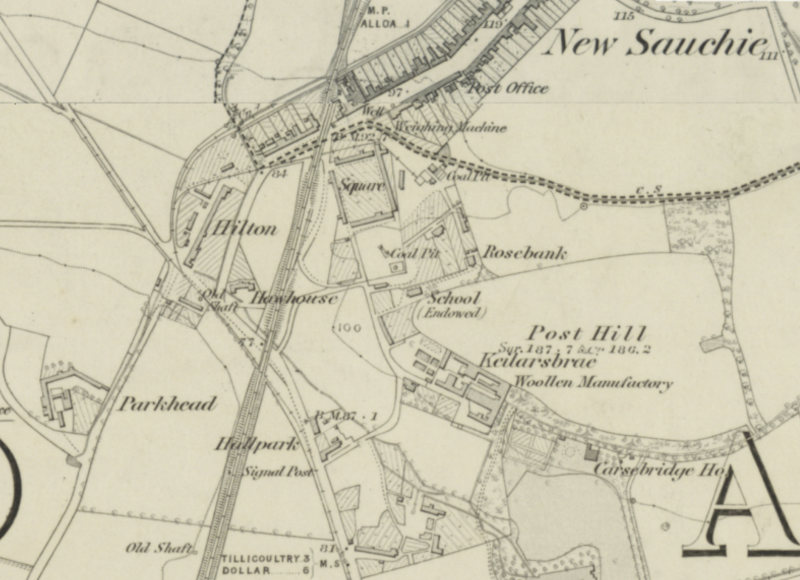
OS map 1843
Sprotwell Pit - Alloa Coal Co. {1873} - Located in Sauchie just north-east of the Holton Pit (now Sprotwell Terrace).
Clackmannan Pit No. 12 and No. 13 - east end of Gartmorn Dam.
Fly Pit - Located to the west of Sauchie near Italy Pond, a former curling pond.
Pumpeye Pit - Located to the west of Sauchie near Fairfield.
Carse Pit - Located in Fairfield Park.
Sheardale
No.1 Sheardale pit - located at Sheardale on the south side of the road.
Tillicoultry
Glenfoot [James Johnstone] {1854}
Tillicoultry [James Snowdone]{1866}, [Tillicoultry Coal Co] {1869}, (Mine no.1) [Alloa Coal Co] {1873}, [Alloa Coal Co] {1893}, [Alloa Coal Co] {1908}, [Alloa Coal Co] {1923}, [Alloa Coal Co] {1938}, [Alloa Coal Co] {1944}, (closed 1957)
Harviestoun - (closed 1961)
Melloch mine - Opened in 1939 By the Alloa Coal Co. and taken over by NCB in 1947, the mine closed in 1948. Melloch mine was located east of Tillicoultry and the Tillicoultry mine in Melloch Wood.
There were 17 pits in the series.
Drummie Mine - Located to the east of Tillicoultry, and served by the railway line.
Tullibody
Tullibody No. 1 was located on the Alloa road at Muirside Road.
Tullibody No. 2 was located at Westview Crescent.
Tullibody No. 3 was located on Alloa Road at the edge of the Blackmuir Wood.
Tullibody No. 5 was located just north of (what is now) Glenochil.
Tullibody No. 10 was located between Knowfaulds Farm and Tullibody Bridge (Bridge over the Devon to Menstrie).
Tullibody No. 11 was located at Knowfaulds Farm.
Tullibody No. 12 was located at Tullibody Bridge (Bridge over the Devon to Menstrie).
Two bores, (No.1 and No.2) were sunk at Tullibody Tannery.
Companies
Alloa Coal Company, The Whins, Alloa.
Clackmannan Coal Company - Owned by a few of the Alloa Coal Company partners, eventually merged into Alloa Coal Company.
Clackmannan Colliery Co.
The National Coal Board
The National Coal Board (NCB) was the statutory corporation created to run the nationalised coal mining industry in the United Kingdom. Set up under the Coal Industry Nationalisation Act 1946, it took over the United Kingdom's collieries on the 1st of January 1947. Under the chairmanship of Lord Hyndley, the NCB took control of the country’s 1,647 mines, over a million acres of land, about 100,000 homes, and transportation equipment and other facilities formerly in the hands of 850 private coal companies. These coal companies were paid £164,600,000 in compensation. In 1987, the NCB was renamed the British Coal Corporation (British Coal), and its assets were subsequently privatised. Following privatisation, in 1997 British Coal was wound up. The Scottish coal fields, much reduced after privatisation, were finally closed when the parent company went into receivership in March 2002, following a sudden and serious flooding incident at the Longannet mine complex.
NCB mines
Brucefield 1905 - April 1961
Craigrie 1938 - August 1952
Devon 1879 - March 1960
Devon No.3 (Meta) 1923 - March 1959
Forthbank 1947 - January 1958
Glenochil - 1952 - June 1962 - Widely considered a failure as it was never viable. Most of the viable coal available at low cost had already been mined by the nearby and older King o' Muirs and Collyland pits.
Harviestoun 1955 to September 1961
King o' Muirs 1 1938 - March 1954
King o' muirs 2 1950 - May 1957
Melloch 1850 - 1948
Solsgirth 1965 - January 1990
Tillicoultry 1866 - Jan 1957
Zetland 1935 - Sept 1960
Longannet Mine Complex
Longannet was the remnant of three mines, established in the 1960s. Built on the north side of the Firth of Forth, east of Kincardine, it connected with the Bogside, Castlehill and Solsgirth Collieries, forming a single, five miles long tunnel. They provided fuel for the nearby 2,400MW Longannet Power Station. The Bogside Colliery closed in the 1980's, and by the early 1990s, the Castlehill and Solsgirth coal reserves were exhausted. Production continued from the Castlebridge Colliery, at Gartlove, near Forestmill.
On privatisation of the coal industry, the complex passed into the ownership of Mining Scotland and later Scottish Coal (Deep Mine) Ltd. In the late 1990s, new "roadway" tunnels were driven to access a coal seam beneath the Forth, downstream of the Kincardine Bridge. When production from Castlebridge ceased in 2000, the northern side of the complex was sealed off and flooded. Dams were constructed, isolating the old workings from the active Kincardine working.
In March 2002, millions of gallons of water flooded into the underground workings. The 15 people below ground at the time were in another part of the mine and all were evacuated safely. Shortly after the flooding (rumoured to be the next day after the accident), Scottish Coal (Deep Mine) Limited, went into receivership. It became clear that no new operator would take over the mine, and all the remaining pumps were switched off, allowing further flooding.
Without access, the true cause of the flooding could not be conclusively determined by the investigation. It was concluded that one of the dams, or the surrounding strata, had probably failed, but the exact reason was not known. The Solsgirth, Bogside, Castlebridge and Castlehill sites were cleared and sold off. The remaining Longannet facility was demolished in 2019. Longannet was the last deep mine of any significance in Scotland and its closure effectively ended underground coal mining in Scotland. As of 2008, opencast coal mining continued in Scotland, with 51.4% of Great Britain's opencast coal mines (18 out of 35 mines) and 60.1% of the saleable production by weight (5.68m tonnes out of 9.45m tonnes).
Longannet Complex Mines:
Longannet 1953 to 23rd March 2002
Bogside 1959 to 1985
Castlehill 1965 to 1990
Solsgirth 1965 to January 1990
Castlebridge 1979 to 23rd March 2002.
Opencast Coal
Meadowhill OCCS, near Forestmill - Opened in1996 with a potential to retrieve 468,000 tons of coal. Its license was extended in 1999 allowing a possible total of 875,000 tons of coal to be retrieved. The site closed in 2005.
Mine - Silver
Alva Silver mine, Silver Glen, Alva:
The discovery of a rich deposit of native silver in 1715 on John Erskine's Alva estate, coincided with the Jacobite rebellion of that year and led to a remarkable story of fortunes made and lost. The mines were later worked for cobalt which was sold to a pottery near Edinburgh to make a blue glaze. The small workings are still visible beside the Silver Burn in the Ochil Hills Woodland Park. The overgrown waste heap has been systematically dug by collectors, and by the National Museum of Scotland. However, very small amounts of dendritic silver can still occasionally be found, with difficulty and perseverance. Cobalt and other elements were also mined here for a time, a considerable amount of cobalt was recovered at the time from the silver mine spoil heap.
Mine - Copper
Copper and other metals were mined in small quantities at Tillicoultry, however there were no commercially viable amounts found.
References: -
Northern Mine Research Society
Coal Mining History Resource Centre
Wikipedia
The Statistical Accounts of Scotland 1795, 1845, 1950-60
One Hundred Years in Coal - The History of the Alloa Coal Company
National Library of Scotland - Georeferenced Maps
